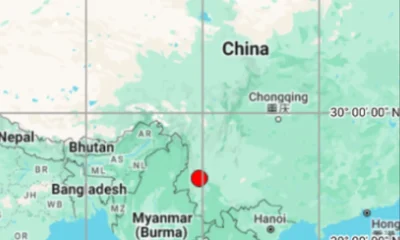Politics
India’s Agni-V Achieves MIRV Tech Success, Contrasting Pakistan’s Failed Attempt Three Years Ago
India’s Agni-V Achieves MIRV Tech Success, Contrasting Pakistan’s Failed Attempt Three Years Ago
Pakistan made a terrible attempt three years ago to create the technology for multiple independently targetable re-entry vehicles (MIRVs) utilizing 2.750 km Shaheen III missiles, with each warhead striking the ground two kilometers apart, according to DRDO high brass. Although the Agni-V missile has a 5000 km range, India tested firing three MIRVs over a distance of more than 3000 kilometers on Monday night. The missile’s name is crucial to MIRV because, at a speed of about six kilometers per second, friction causes the warhead to split apart in space and the missile to reenter the atmosphere looking like an Agni flame. Every warhead descends at a separate rate and strikes the earth at a distance of around 200 kilometers between the points of impact. Re-entry is crucial to MIRV because if the warhead is not composed of carbon composites, it could disintegrate.
The successful test of Agni-V indicates that India’s nuclear missile force is prepared to deter any opponent, and work is already underway to create the Agni-P generation of multipurpose missiles. India has also successfully tested the K-4 submarine-launched ballistic missile, which has a range of 3700 kilometers. The Agni-V test will be used by Pakistan and its bigger sister China to keep Islamabad from signing the Fissile Material Cut-off Treaty (FMCT) due to the unequal conventional force levels with India. On the other hand, China’s expansionist goals are what the Agni-V MIRV is designed to counter. China still harbors territorial ambitions in India despite violently seizing Tibet in 1950. The truth is that, following India’s March 7 NOTOM for test trials, the PLA sent its two Xiang Yang Hong class spy ships to observe the Agni V test with Hong 01 when it crossed the Malacca Straits on March 7-8 night. The sister ship Hong 03 is currently outside the Maldivian EEZ monitoring the effects of the Indian missile launch in the South Indian Ocean, while Hong 01 is currently stationed 500 km west of Vizag.
Also Read: PM Modi Criticizes INDIA Bloc as ‘Full of Negativity’ at Dwarka Expressway Inauguration
China has been constructing intermediate-range nuclear ballistic missiles at a quick pace, and this is primarily to blame for India’s decision to test-fire the MIRV-equipped Agni-V. China was not included in the now-virtually obsolete Intermediate Range Nuclear Forces Treaty between the US and Russia in 1987. As the Agni V is carrying many nuclear warheads, each with a unique target and velocity, anti-missile shields are unable to intercept them. According to reliable sources, there will be no additional test firings because the goal has been accomplished and project handlers have returned to headquarters, despite the fact that India has issued NOTAMs for March 15–16. The project directors will now review the missile’s trajectory and other data captured by the Indian ballistic missile tracker INS Dhruv in order to make any necessary operational adjustments. It’s a success, Mission Divyastra.












